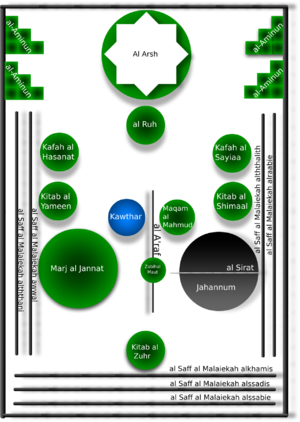Religion:Day of Resurrection
In Islamic eschatology, the Day of Resurrection (Arabic: يوم القيامة) is believed to be God's final assessment of humanity. Other names for it in the Quran are the Day of Reckoning, the Last Day, and the Hour (al-sā'ah). The sequence of events (according to the most commonly held belief) is the annihilation of all creatures, the resurrection of the body, and the judgment of all sentient beings. At this time everyone is shown their deeds and actions in regard to justice.
Belief in Resurrection Day is considered a fundamental tenet of faith by all Muslims: it is one of the six articles of faith. The trials and tribulations associated with it are detailed in both the Quran and the hadith (the sayings of Muhammad), and they have been commented on and explained in the commentaries of important Islamic expositors and scholarly authorities such as al-Ghazali, Ibn Kathir, Ibn Majah, Muhammad al-Bukhari, and Ibn Khuzaimah. Every human, Muslim and non-Muslim alike, is believed to be held accountable for their deeds and to be judged by Allah accordingly.
Time
The exact time when these events are supposed to occur is unknown, however there are said to be major[1] and minor signs[2] which are to occur near the time of Qiyammah (end time). It is believed that prior to the time of Qiyammah, two dangerous, evil tribes called Ya'jooj and Ma'jooj are released from a dam-resembling wall that Allah makes stronger everyday. Other signs being the coming of Isa bin Maryam (Jesus), appearance of Antichrist (Al-Masih ad-Dajjal), the sun rising from the west, and the Beast of the Earth. The coming of the rain of mercy that will cause humans to re-grow from their عجز (sacrums)[3] Many verses of the Quran, especially the earlier ones, are dominated by the idea of the nearing of the Day of Resurrection.[4][5]
Mention in Quran

A consistent theme throughout the Quran is the suspension of a final verdict on matters of religious difference until the Day of Judgment (see Q3:55; Q5:48; Q6:164; Q10:93; Q16:92; Q16:124; Q22:69; Q32:25; Q39:3, Q46).[7]
Event
After all the minor signs and nine major signs are completed, the archangel Israfil will blow the first trumpet which would cause all human beings to die. Subsequently, Israfil will blow the trumpet for the second time which would cause all human beings who’ve ever lived to become alive and head towards the plain of Arafat for the Day of Resurrection.[citation needed]
Nasir Khusraw (d. after 1070), an Ismaili thinker of the Fatimid era, presents another understanding of the Day of Resurrection. He argues that the Resurrection (Qiyāma) will be ushered by the Lord of the Resurrection (Qāʾim al-Qiyāma), an individual representing the purpose and pinnacle of creation from among the progeny of Muhammad and his Imams. Through this individual, the world will come out of darkness and ignorance and "into the light of its Lord" (Quran 39:69). His era, unlike that of the enunciators of the divine revelation (nāṭiqs) before him, is not one where God prescribes the people to work but instead one where God rewards them. Preceding the Lord of the Resurrection (Qāʾim) is his proof (ḥujjat). The Quranic verse stating that “the night of power (laylat al-qadr) is better than a thousand months” (Quran 97:3) is said to refer to the proof of the Lord of the Resurrection, whose knowledge is superior to that of a thousand Imams, though their rank, collectively, is one. Hakim Nasir also recognizes the successors of the Lord of the Resurrection to be his deputies (khulafāʾ).[8]
See also
References
- ↑ "Major Signs before the Day of Judgment (Qiyamah)". inter-islam.org. http://www.inter-islam.org/faith/Majorsigns.html.
- ↑ "Signs Of Qiyaamah". inter-islam.org. http://www.inter-islam.org/faith/Signs-Of-Qiyaamah.htm.
- ↑ https://www.medicinenet.com/script/main/art.asp?articlekey=6970 retrieved 22.37 on 15/1/20.
- ↑ Isaac Hasson, Last Judgment, Encyclopaedia of the Qur'an.
- ↑ L. Gardet, Qiyama, Encyclopaedia of the Qur'an.
- ↑ Begley, Wayne E. The Garden of the Taj Mahal: A Case Study of Mughal Architectural Planning and Symbolism, in: Wescoat, James L.; Wolschke-Bulmahn, Joachim (1996). Mughal Gardens: Sources, Places, Representations, and Prospects Dumbarton Oaks, Washington D.C., ISBN 0884022358. pp. 229-231.
- ↑ Dagli, Caner (April 2015). 2, The Cow, al-Baqarah Study Quran. San Francisco: HarperOne.
- ↑ Virani, Shafique. "The Days of Creation in the Thought of Nasir Khusraw" (in en). Nasir Khusraw: Yesterday, Today, Tomorrow. https://www.academia.edu/37219457/The_Days_of_Creation_in_the_Thought_of_Nasir_Khusraw.
